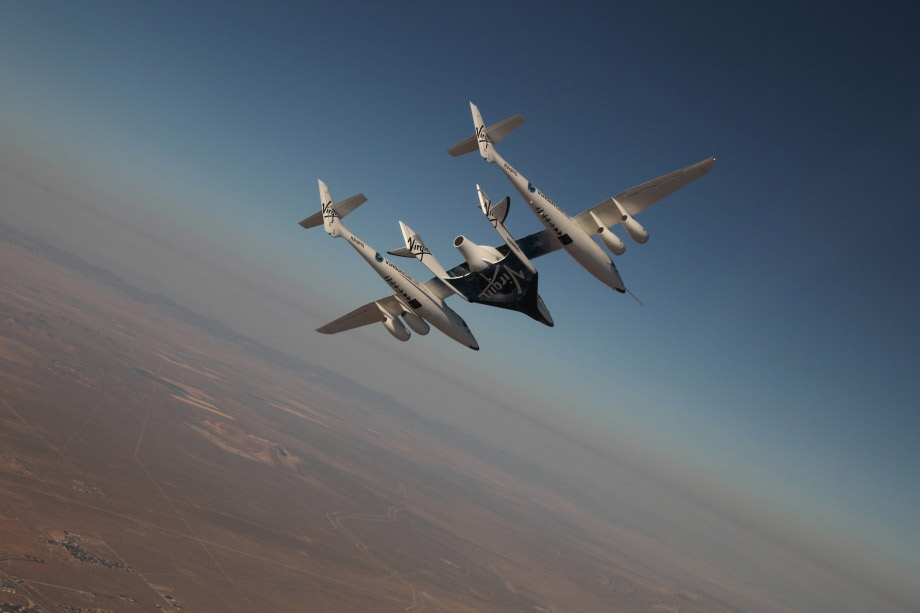Virgin Galactic's Private Spaceship Makes First Crewed Flight

A private suborbital spaceship built for the space tourismfirm Virgin Galactic made its first flight with a crew onboard Thursday as itsoared over California's Mojave Desert beneath its enormous mothership.
The commercial spaceliner ? called VSSEnterprise, one of the company's fleet of SpaceShipTwospacecraft ? did not try to reach space in the test flight.Instead, it stayed firmly attached to its WhiteKnightTwo VMSEve mothership.
The two crewmembers riding onboard VSSEnterprise evaluated all of the spacecraft?s systems and functions duringthe 6-hour, 12-minute flight, Virgin Galactic officials said in a statement. Inaddition, automated sensors and ground crews conducted thorough vehicle systemstests. [Photos from the SpaceShipTwo test flight.]
"Objectives achieved," Virgin Galactic officialssaid in a statement on the company's website. "Congratulations to thewhole team!"
Three other crewmembers flew aboard the Eve mothership,which is designed to carry SpaceShipTwo to an altitude above 50,000 feet (15,240meters) before the spacecraft drops and fires its hybrid rocket motor to launchinto suborbital space.
Virgin Galactic was founded by British billionaire SirRichard Branson. The SpaceShipTwo spacecraft and their WhiteKnightTwomotherships are built for Virgin Galactic by Mojave, Calif.-based ScaledComposites, which was founded by veteran aerospace designer Burt Rutan.
SpaceShipTwo is built to carryeight people (six passengers and two pilots) on suborbital flights thatwould reach outer space for a few minutes, though would not go high enough toenter Earth orbit.
Breaking space news, the latest updates on rocket launches, skywatching events and more!
The flights will provide a weightless experience and aview of the blackness of space and glowing Earth below. Tickets cost $200,000per person.
Rutan and Scaled Composites also built SpaceShipTwo'spredecessor, the smaller suborbital craft SpaceShipOne financed by Microsoftco-founder Paul Allen, which won the $10 million Ansari X Prize for reusable,manned suborbital spacecraft in 2004.
Thursday's captive flight test was the 33rd voyage of themothership VMS Eve, one of company's the WhiteKnightTwo craft. It was the thirdcaptive-carry flight for VSS Enterprise. The first ofthese joint flights occurred earlier this year in March.
The mothership crew consisted of Mark Stucky, PeterKalogiannis and Brian Maisler, while Peter Siebold and Michael Alsbury rodeaboard VSS Enterprise.
The VSS Enterprise is the first in a planned fleet ofsuborbital SpaceShipTwo spacecraft for Virgin Galactic. While the first testflights are being flown from Mojave, Calif., Virgin Galactic is building aterminal for space tourism flights at Spaceport America in New Mexico as well.
The VSS Enterprise named after the fictional starship of thesame name from the science fiction television franchise "Star Trek."
- Top 10 Private Spaceships Becoming Reality
- Photos - SpaceShipTwo's First Captive Flight, WhiteKnightTwo
- Video - SpaceShipTwo Goes Airborne for 1st Time

Clara Moskowitz is a science and space writer who joined the Space.com team in 2008 and served as Assistant Managing Editor from 2011 to 2013. Clara has a bachelor's degree in astronomy and physics from Wesleyan University, and a graduate certificate in science writing from the University of California, Santa Cruz. She covers everything from astronomy to human spaceflight and once aced a NASTAR suborbital spaceflight training program for space missions. Clara is currently Associate Editor of Scientific American. To see her latest project is, follow Clara on Twitter.
